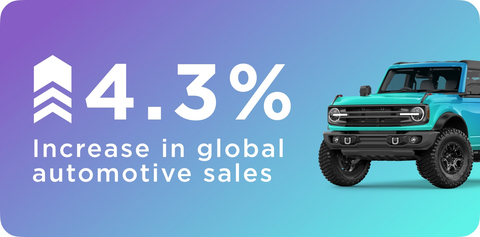BigCommerce Finds Automotive Ecommerce is Poised for Growth as the Industry Shifts Gears to Online
- 4.3% increase in GMV for automotive merchants compared to Q1 2022
- 5% increase in AOV between Q1 2022 and Q1 2023
- 9.1% increase in GMV for automotive category between Q1 2022 and Q1 2023
- 4.8% increase in orders via iPhone between Q1 2022 and Q1 2023
- Notable YoY improvement in B2B selling with 9.1% increase in GMV and 8.7% increase in AOV for automotive industry
- 4.8% increase in YoY GMV in North America for automotive category
- 1.7% increase in GMV in EMEA for automotive category
- 3.5% increase in AOV and zero change in GMV for automotive industry between Q1 2022 and Q1 2023
- 4% decrease in orders via Android for automotive industry between Q1 2022 and Q1 2023
- Flat performance in automotive GMV, orders, and AOV in APAC
Insights
Analyzing...
Performance data cultivated from BigCommerce merchants show automotive category is picking up speed online, while omnichannel selling, data analytics and car subscription services are navigating the future of automotive ecommerce

Q1 2023 BigCommerce data showed a
The automotive industry is quickly shifting gears to ecommerce, leveraging new strategies such as digital advertising, virtual showrooms, flexible payment options and online vehicle marketplaces. And in the future, omnichannel selling, data analytics and subscription services seem poised to become the next big trends for automotive ecommerce.
Key findings include:
-
Q1 2023 data showed a
4.3% increase in gross merchandise volume (GMV) for automotive merchants compared to Q1 2022. Similar growth held true for automotive’s average order value (AOV), which saw a5% increase between Q1 2022 and Q1 2023. -
Between Q1 2022 and Q1 2023, the automotive category saw a
9.1% increase in GMV, a4.1% increase in AOV and a4.8% increase in orders via iPhone. However, by the same measure, the automotive industry saw a3.5% increase in AOV, zero change for GMV and a4% decrease in orders via Android. -
When it comes to pure B2B selling, the automotive industry is showing notable YoY improvement. Automotive GMV was up
9.1% from Q1 2022, AOV was up8.7% , while orders remained relatively flat.
How the automotive industry performed
If the trends of Q1 remain constant or improve, our data also shows the automotive category is poised for growth in 2023.
-
Mobile sales experienced a slight increase
Data revealed only a slight increase in mobile sales for the automotive category. Comparing Q1 2022 to Q1 2023, automotive merchants experienced a5% increase in GMV, zero change in orders and a4.1% increase in AOV. When comparing order sources, however, online sales via iPhone slightly outperformed sales via Android.
Between Q1 2022 and Q1 2023, the automotive category saw a9.1% increase in GMV, a4.1% increase in AOV and a4.8% increase in orders via iPhone. However, by the same measure, the automotive industry saw a3.5% increase in AOV, zero change for GMV and a4% decrease in orders via Android.
-
Automotive merchants pick up speed with B2B
When it comes to pure B2B selling, the automotive industry is showing notable YoY improvement. Automotive GMV was up9.1% from Q1 2022, AOV was up8.7% , while orders remained relatively flat.
Hybrid B2B (merchants selling both B2C and B2B) numbers also showed some improvement. Automotive GMV was up3.3% and AOV was up7% , while orders were down3.4% .
-
Automotive sees growth in AMER and EMEA
While still trailing overall ecommerce performance, the automotive category did experience slight growth inNorth America , with a4.8% increase in YoY GMV and5.2% increase in AOV.
In EMEA, automotive merchants saw a1.7% increase in GMV between Q1 2022 and Q1 2023, as well as a5.1% increase in AOV, while orders decreased by3.3% . In APAC, however, automotive GMV, orders and AOV all remained relatively flat.
Ecommerce trends and predictions shaping the automotive category
Automotive merchants are revving up their ecommerce strategies and show no signs of slowing. But as a newer retail category in the ecommerce space, the automotive industry has found some unique ways to excel online. Here are some notable ecommerce trends we found that are shaping the automotive category in 2023:
-
Digital showrooms bring the dealership experience online
With the help of new technologies, automotive brands are able to create an immersive ecommerce experience that mimics that of a dealership. Digital showrooms will not only enable users to customize the features, trim and model of their car, but also perform virtual test drives and demos. For instance, BigCommerce merchant BB Wheels is bringing the showroom online with their interactive Vehicle Visualizer tool which enables customers to easily visualize how a specific wheel will look on a particular vehicle.
-
Digital advertising helps drive revenue
While it’s still common to see automotive billboards and television ads, an increasing number of auto retailers are turning to social channels like Facebook, Google and Instagram to engage with customers and showcase new products. Not only can this increase brand awareness, but it also allows auto retailers to collect first-party data in order to better tailor the advertising experience for the customer.
-
Convenient payment options to streamline the experience
According to a survey of dealers by PwC,66% of car dealers agreed that customers expect purchasing information in digital form, particularly regarding financing options. Needless to say, purchasing has been a major pain point for car shoppers, leading both online and traditional dealers to think outside the box when it comes to payment options. Mobile wallets, payment scheduling and contactless transactions are just a few of the payment solutions changing the game in auto retail today.
-
Vehicle marketplaces rev up online sales
By integrating with third-party marketplaces such as Amazon, O’Reilly Auto Parts, Walmart and even Ebay, automotive companies can take advantage of a customer base on platforms already proven to succeed. We see rising demand from online car buyers and third-party vehicle marketplaces will have positioned themselves to fill the gap left by traditional dealers.
Navigating the future of automotive ecommerce
While the automotive industry has already undergone a major transformation, the future holds even more potential. From data analytics to online subscription services, the future of automotive ecommerce is coming in full speed.
-
Omnichannel selling creates a connected user experience
While many automotive customers are moving online, there remains a clear need for the in-dealership experience — which doesn’t seem to be disappearing anytime soon. Thus, automotive retailers will need to implement a holistic omnichannel strategy that weaves together all business channels, both online and offline, to create a consistent and engaging customer experience.
-
Data analytics provide customer insights
Particularly for dealers selling both online and offline, data analytics can be a powerful tool for improving inventory management by reducing overstocking or understocking. Additionally, big data and predictive analytics can provide insight into customer behavior, such as how long a customer spends on a page, what they’re browsing and what products they’re adding to their carts.
-
Subscription services disrupt car ownership
Today, nearly all ecommerce industries offer some sort of subscription service. According to a survey by PwC, roughly 4 in 10 consumers say they would consider using a car subscription service for their next vehicle, and71% of dealers claim that subscription services are a “viable business model for their franchisees. Not only do subscription business models provide a flexible alternative for the customer, but they also help create new revenue streams for the dealer.
“BigCommerce is trusted by more than 2,600 automotive sites across the world, and our merchant data shows the power ecommerce has to fuel an industry leaning into digital transformation to better engage and sell to their customers,” said Lisa Eggerton, chief marketing officer at BigCommerce. “The opportunity for growth and innovation is remarkable.”
Read the full report here. To explore BigCommerce’s automotive ecommerce solutions and how they help transform how to sell auto parts online, click here.
Methodology
BigCommerce’s automotive data is sourced directly from our merchants and was pulled on May 16, 2023. All data is global and pertains to all countries where BigCommerce merchants do business, unless otherwise noted.
All comparisons are congruent comparisons between the same number of existing stores dating back to the earliest period used in the comparison. For example, a comparison between Q1 of 2022 and Q1 2023 would use data only from BigCommerce stores that existed in Q1 2022, unless otherwise noted.
About BigCommerce
BigCommerce (Nasdaq: BIGC) is a leading open software-as-a-service (SaaS) ecommerce platform that empowers merchants of all sizes to build, innovate and grow their businesses online. BigCommerce provides merchants sophisticated enterprise-grade functionality, customization and performance with simplicity and ease-of-use. Tens of thousands of B2C and B2B companies across 150 countries and numerous industries use BigCommerce to create beautiful, engaging online stores, including Ben & Jerry’s, Molton Brown, S.C. Johnson, Skullcandy, Solo Stove, Ted Baker and Vodafone. Headquartered in
BigCommerce® is a registered trademark of BigCommerce Pty. Ltd. Third-party trademarks and service marks are the property of their respective owners.
View source version on businesswire.com: https://www.businesswire.com/news/home/20230621827944/en/
Dana Marruffo
dana.marruffo@bigcommerce.com
Source: BigCommerce







